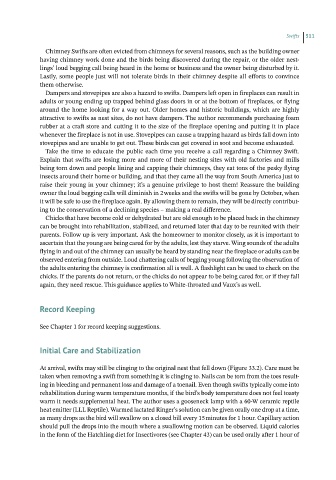Page 514 - Hand rearing birds second
P. 514
Swifts 511
Chimney Swifts are often evicted from chimneys for several reasons, such as the building owner
having chimney work done and the birds being discovered during the repair, or the older nest-
lings’ loud begging call being heard in the home or business and the owner being disturbed by it.
Lastly, some people just will not tolerate birds in their chimney despite all efforts to convince
them otherwise.
Dampers and stovepipes are also a hazard to swifts. Dampers left open in fireplaces can result in
adults or young ending up trapped behind glass doors in or at the bottom of fireplaces, or flying
around the home looking for a way out. Older homes and historic buildings, which are highly
attractive to swifts as nest sites, do not have dampers. The author recommends purchasing foam
rubber at a craft store and cutting it to the size of the fireplace opening and putting it in place
whenever the fireplace is not in use. Stovepipes can cause a trapping hazard as birds fall down into
stovepipes and are unable to get out. These birds can get covered in soot and become exhausted.
Take the time to educate the public each time you receive a call regarding a Chimney Swift.
Explain that swifts are losing more and more of their nesting sites with old factories and mills
being torn down and people lining and capping their chimneys, they eat tons of the pesky flying
insects around their home or building, and that they came all the way from South America just to
raise their young in your chimney; it’s a genuine privilege to host them! Reassure the building
owner the loud begging calls will diminish in 2 weeks and the swifts will be gone by October, when
it will be safe to use the fireplace again. By allowing them to remain, they will be directly contribut-
ing to the conservation of a declining species – making a real difference.
Chicks that have become cold or dehydrated but are old enough to be placed back in the chimney
can be brought into rehabilitation, stabilized, and returned later that day to be reunited with their
parents. Follow up is very important. Ask the homeowner to monitor closely, as it is important to
ascertain that the young are being cared for by the adults, lest they starve. Wing sounds of the adults
flying in and out of the chimney can usually be heard by standing near the fireplace or adults can be
observed entering from outside. Loud chattering calls of begging young following the observation of
the adults entering the chimney is confirmation all is well. A flashlight can be used to check on the
chicks. If the parents do not return, or the chicks do not appear to be being cared for, or if they fall
again, they need rescue. This guidance applies to White-throated and Vaux’s as well.
RecordKeeping
See Chapter 1 for record keeping suggestions.
InitialCareand Stabilization
At arrival, swifts may still be clinging to the original nest that fell down (Figure 33.2). Care must be
taken when removing a swift from something it is clinging to. Nails can be torn from the toes result-
ing in bleeding and permanent loss and damage of a toenail. Even though swifts typically come into
rehabilitation during warm temperature months, if the bird’s body temperature does not feel toasty
warm it needs supplemental heat. The author uses a gooseneck lamp with a 60-W ceramic reptile
heat emitter (LLL Reptile). Warmed lactated Ringer’s solution can be given orally one drop at a time,
as many drops as the bird will swallow on a closed bill every 15 minutes for 1 hour. Capillary action
should pull the drops into the mouth where a swallowing motion can be observed. Liquid calories
in the form of the Hatchling diet for Insectivores (see Chapter 43) can be used orally after 1 hour of

